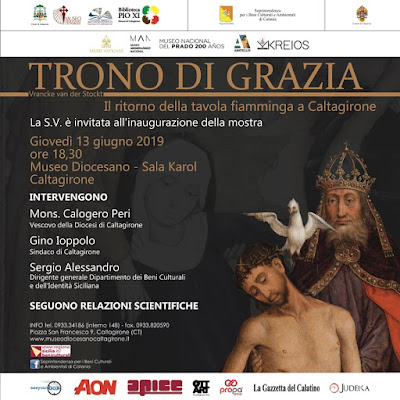“Trono di Grazia 4.0” is a very innovative
project taking advantage of IoT technologies to deliver an all-inclusive
solution for the fine arts logistics and exhibition.
Thanks to the real-time data collection and analysis,
it’s possible to share alerts and core information with all stakeholders along
all steps of a nail2nail transport, in order to prevent potential damages to
the masterpiece.
The project was born thanks to a collaboration
among See Your Box, Aon Italy for the risk consulting, Apice for the fine arts
logistics, Ott Art for the climate-controlled showcases, Propagroup for the
packaging hygroscopic materials and the Diocesan Museum of Caltagirone, owner
of the painting.
Such a strong collaboration made possible to
provide an all-inclusive service, which thanks to continuous data analysis
allows a better management of the risk connect to transports, packaging,
insulating materials, showcases for exhibitions, and an automated but accurate
calculation of insurance risk profiles.
The project “Trono di Grazia 4.0” started back
in 2014 when, thanks to See Your Box, the painting was transported to the
Vatican Museums for a long and delicate renovation process.
This year, on March 29, the project “Trono di
Grazia 4.0” was kicked-off at the Vatican Museums, where Fabio Raimondi,
director of the Museum of Caltagirone, and Barbara Jatta, director of the
Vatican Museums, presented publicly the renovated painting Trono di Grazia,
by the Flemish painter Vrancke van der Stockt.
The meticulous renovation was carried on by the
Laboratories of the Vatican Museums, where the painting has been on display for
around two months. The artwork is now going back to the Diocesan Museum of
Caltagirone (Sicily, Italy), where it will be presented during a public event,
next Thursday 13 June, together with an artwork, by the same author, lent by
the National Archaeological Museum of Madrid. Both paintings are part of the
exhibition titled “Trono di Grazia. Il ritorno della tavola fiamminga a Caltagirone” (“Trono di Grazia. The return of the Flemish painting to
Caltagirone”). The project lasts 2 years and allows partners to periodically
meet to analyse and discuss data collected by the monitoring system.
A nail2nail monitoring requires a continuous data collection: in the original
museum, along the packing, transport and exhibition setup in the museum of
destination, during the temporary exhibition itself and on the way back to the
home museum. Delivering such a kind of monitoring is possible thanks to the
extreme versatility and adaptability of the system and to the sophisticated AI
algorithms, which enable the device to automatically understand in which phase
of the complex process it is, self-adapting its behaviour and the parameters
detected, without any human intervention.
For example, by monitoring the
variations in light intensity, the device is able to understand if the painting
is exhibiting in a museum (constantly exposed to light) or inside a package,
where light intensity and time of exposure are clearly reduced. In the same
way, by monitoring the incline and the vibrations, the system understands if
the painting is hanged on a wall or packed in a box, subject to small
vibrations caused by the pavement. Furthermore, the devices can monitor for up
to 5 months without any need for recharge, collecting and sending data at
constant intervals.
The technology is extremely simple: the devices don’t need any further
integration; the whole system is continuously and autonomously monitored by
servers. Once selected via the online platform, all parameters are transmitted
after the device has been turned on by simply pressing the button. A full range
of 60 parameters are collected every 10 minutes, all variations exceeding
predefined thresholds are immediately transmitted with a detailed message to
all linked users. All this can be accessed in real time through a web platform.
The mission of the project “Trono di Grazia 4.0” is actually to provide
artworks owners, be they a museum or a private collector, with an all-inclusive
new-generation monitoring service, allowing to keep under control all life
stages of a masterpiece, from its stay in museums and collections, to the
transport, the planning of renovations and the management of risk.

